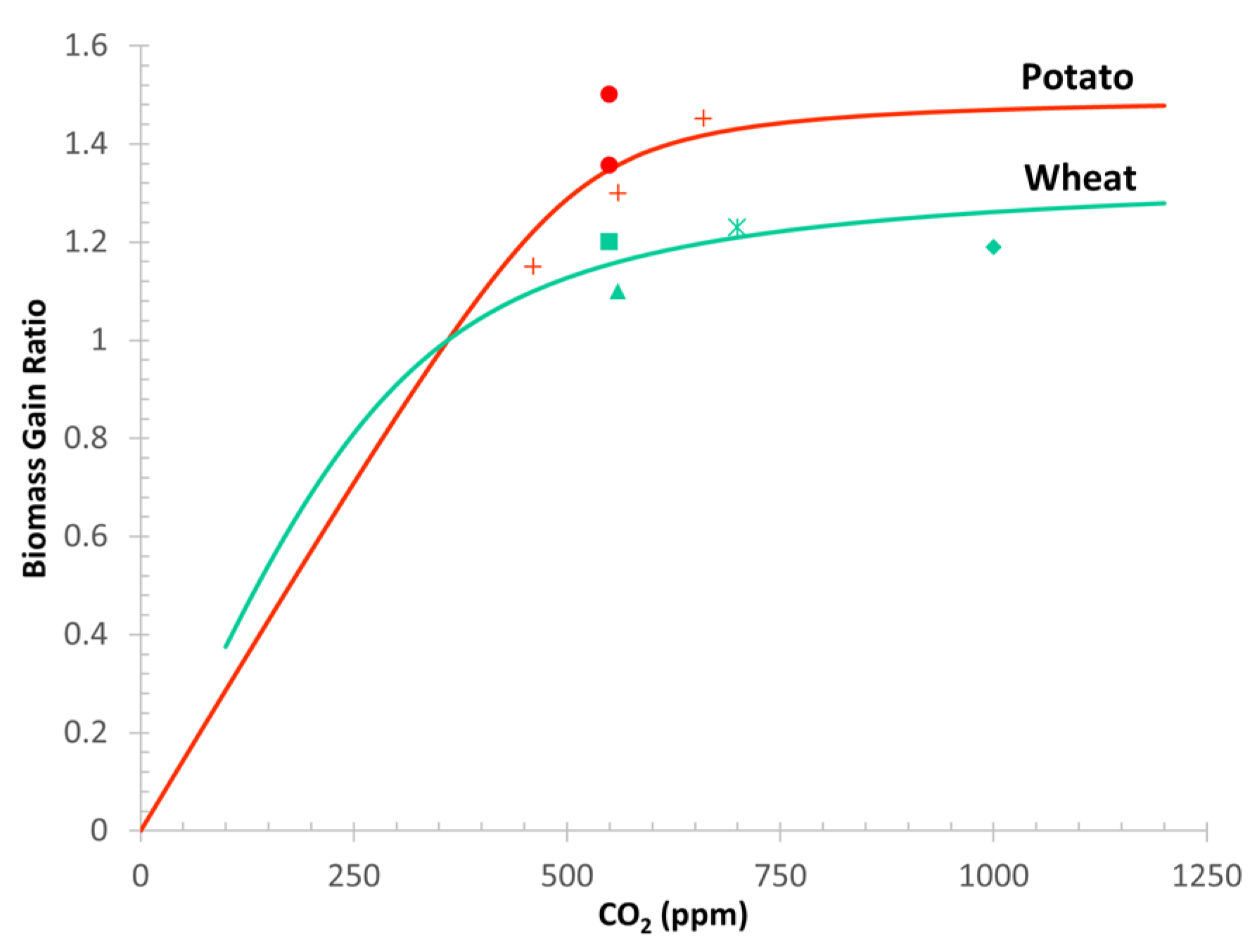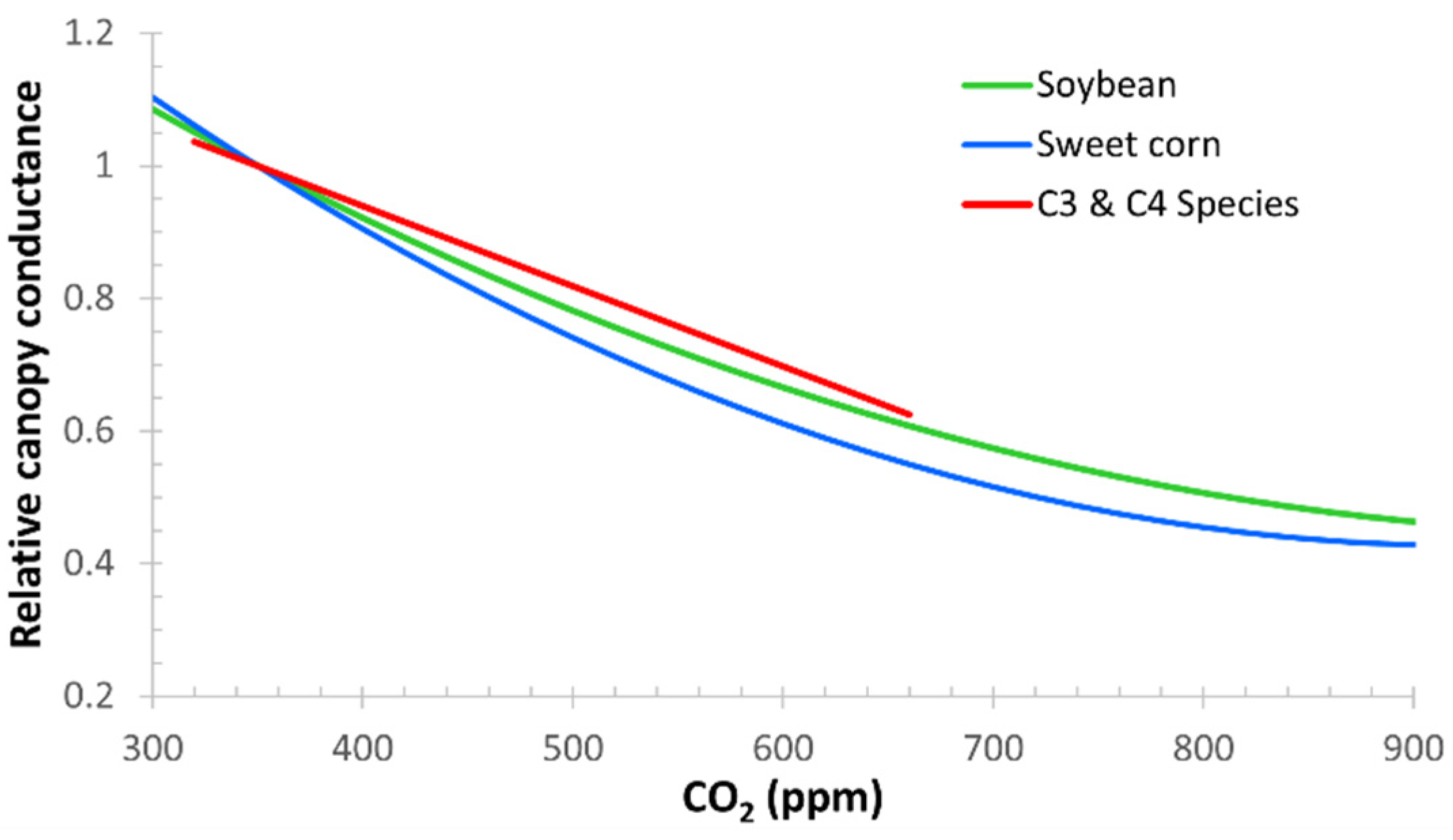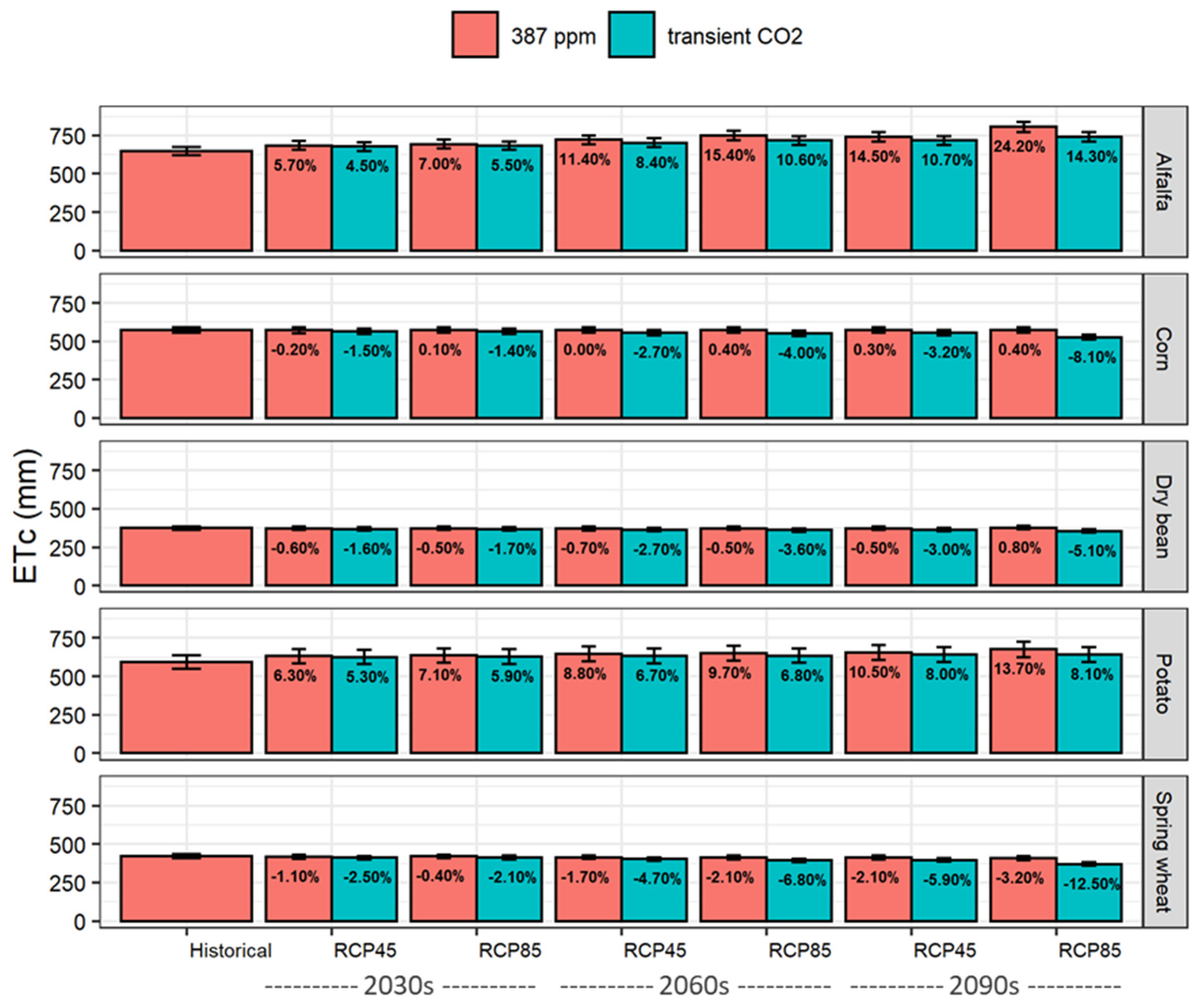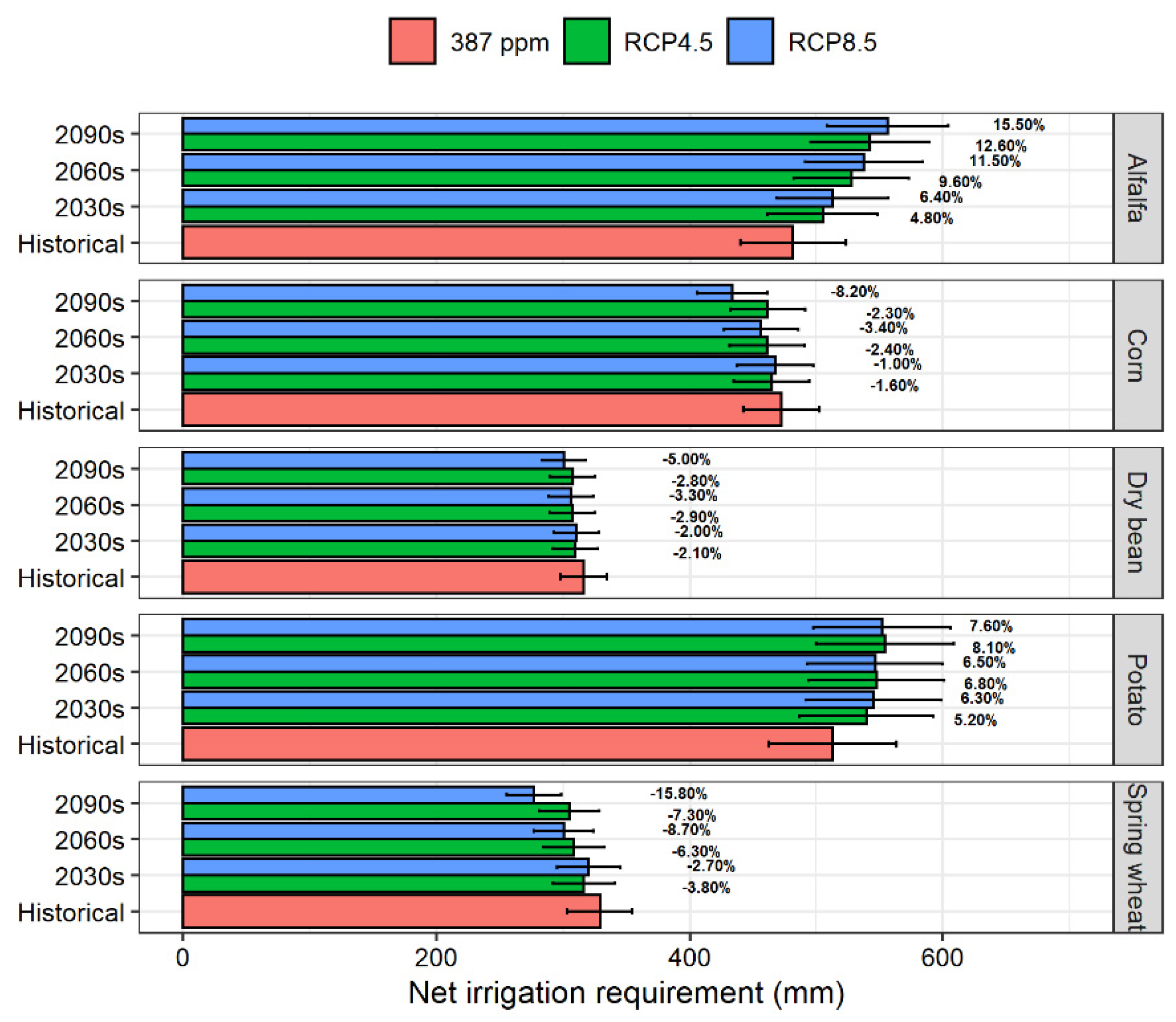Evapotranspiration of Irrigated Crops under Warming and Elevated Atmospheric CO2: What Is the Direction of Change?
Abstract
:1. Introduction
2. Materials and Methods
2.1. Study Area
2.2. Simulation Scenarios
2.3. CropSyst Model
2.4. CropSyst Calibration
2.5. Irrigation Management
3. Results and Discussion
3.1. Changes in Climate
3.2. Changes in Crop Cycle Length
3.3. Changes in Atmospheric Evaporative Demand (ETo)
3.4. Atmospheric CO2 Concentration Effect on ETc
3.5. Effect of Planting Dates on ETc
3.6. Changes in Net Irrigation Requirement (NIR)
3.7. Overall Considerations
4. Conclusions
Author Contributions
Funding
Institutional Review Board Statement
Informed Consent Statement
Data Availability Statement
Conflicts of Interest
Abbreviations
| CBP | Columbia River Project |
| CMIP5 | Coupled Model Intercomparison Project Phase 5 |
| ET | Evapotranspiration |
| ETo | Reference evapotranspiration |
| ETc | Crop evapotranspiration |
| ETp | Potential evapotranspiration |
| FACE | Free-air concentration enrichment |
| FAO | Food and Agriculture Organization of the United Nations |
| GCC | Green crop canopy |
| GCM | General Circulation Models |
| IPCC | Intergovernmental Panel on Climate Change |
| Kc | Crop coefficient |
| NLDAS-2 | Phase 2 of the North American Land Data Assimilation System |
| NIR | Net irrigation requirement |
| NRH | Non-rectangular hyperbola |
| PRISM | Parameter-elevation Relationships on Independent Slopes Model |
| RCP | Representative Concentration Pathways |
| RBG | Relative biomass gain |
| SWAT | Soil & Water Assessment Tool |
References
- Scarpare, F.V.; Hernandes, T.A.D.; Ruiz-Corrêa, S.T.; Picoli, M.P.A.; Scanlon, B.R.; Chagas, M.F.; Duft, D.G.; Cardoso, T.F. Sugarcane land use and water resources assessment in the expansion area in Brazil. J. Clean. Prod. 2016, 133, 1318–1327. [Google Scholar] [CrossRef]
- Marin, F.R.; Jones, J.W.; Singles, A.; Royce, F.; Assad, E.D.; Pellegrino, G.Q.; Justino, F. Climate change impacts on sugarcane attainable yield in southern Brazil. Clim. Chang. 2013, 177, 227–239. [Google Scholar] [CrossRef] [Green Version]
- Stöckle, C.O.; Nelson, R.L.; Higgins, S.; Brunner, J.; Grove, G.; Boydston, R.; Whiting, M.; Kruger, C. Assessment of climate change impact on Eastern Washington agriculture. Clim. Chang. 2010, 102, 77–102. [Google Scholar] [CrossRef] [Green Version]
- Izaurralde, R.C.; Rosenberg, N.J.; Brown, R.A.; Thomson, A.M. Integrated assessment of Hadley Center (HadCM2) climate-change impacts on agricultural productivity and irrigation water supply in the conterminous United States: Part II. Regional agricultural production in 2030 and 2095. Agric. For. Meteorol. 2003, 117, 97–122. [Google Scholar] [CrossRef]
- Katerji, N.; Rana, G.; Ferrara, R.M. Actual evapotranspiration for a reference crop within measured and future changing climate periods in the Mediterranean region. Theor. Appl. Climatol. 2017, 93, 129–923. [Google Scholar] [CrossRef]
- Allen, R.G.; Pereira, L.S.; Raes, D.; Smith, M. Crop Evapotranspiration—Guidelines for Computing Crop Water Requirements-FAO Irrigation and drainage paper 56. Fao Rome 1998, 300, D05109. [Google Scholar]
- Khalil, A.A. Effect of climate change on evapotranspiration in Egypt. Researcher 2013, 5, 7–12. [Google Scholar]
- Tao, X.; Chen, H.; Xu, C.; Hou, Y.; Jie, M. Analysis and prediction of reference evapotranspiration with climate change in Xiangjiang River Basin, China. Water Sci. Eng. 2015, 8, 273–281. [Google Scholar] [CrossRef] [Green Version]
- Sunil, A.; Depthi, B.; Miralkar, A.B.; Adarsh, S. Modeling future irrigation water demands in the context of climate change: A case study of Jayakwadi command area, India. Model. Earth Syst. Environ. 2020, 7, 1963–1977. [Google Scholar] [CrossRef]
- Ashoften, P.S.; Bozorg-Haddad, O.; Loáiciga, H.A. Development of adaptive strategies for irrigation water demand management under climate change. J. Irrig. Drain Eng. 2017, 143, 04016077. [Google Scholar] [CrossRef]
- Liu, Z.; Lu, J.; Huang, J.; Chen, X. Projection of reference crop evapotranspiration under future climate change in Poyang Lake watershed, China. J. Hydrol. Eng. 2021, 26, 05020042. [Google Scholar] [CrossRef]
- Roba, N.T.; Kassa, A.K.; Geleta, D.M. Modeling climate change impacts on crop water demand, middle Awash River basin, case study of Berehet woreda. Water Pract. Technol. 2021, 16, 864–885. [Google Scholar] [CrossRef]
- Gorguner, M.; Kavvas, M.L. Modeling impacts of future climate change on reservoir storages and irrigation water demands in a Mediterranean basin. Sci. Total Environ. 2020, 748, 141246. [Google Scholar] [CrossRef] [PubMed]
- Saadi, S.; Todorovic, M.; Tanasijevic, L.; Prereira, L.S.; Pizzigalli, C.; Lionello, P. Climate change and Mediterranean agriculture: Impacts on winter wheat and tomato crop evapotranspiration, irrigation requirements and yield. Agric. Water Manag. 2015, 147, 103–115. [Google Scholar] [CrossRef]
- Li, Z.; Fang, G.; Chen, Y.; Duan, W.; Mukanov, Y. Agricultural water demands in Central Asia under 1.5 °C and 2.0 °C global warming. Agric. Water Manag. 2020, 231, 106020. [Google Scholar] [CrossRef]
- Woznicki, S.A.; Nejadhashemi, A.P.; Parsinejad, M. Climate change and irrigation demand: Uncertainty and adaptation. J. Hydrol. Reg. Stud. 2015, 3, 247–264. [Google Scholar] [CrossRef]
- Chen, X.; Qi, Z.; Gui, D.; Ma, L.; Zeng, F.; Li, L. Simulating impacts of climate change on cotton yield and water requirement using RZWQM2. Agric. Water Manag. 2019, 222, 231–241. [Google Scholar] [CrossRef]
- Rajagopalan, K.; Chinnayakanahalli, K.J.; Stöckle, C.O.; Nelson, R.L.; Kruger, C.E.; Brady, M.P.; Malek, K.; Dinesh, S.T.; Barber, M.E.; Hamlet, A.F.; et al. Impacts of near-term climate change on irrigation demands and crop yields in the Columbia River Basin. Water Resour. Res. 2018, 54, 2152–2182. [Google Scholar] [CrossRef]
- Kimball, B.A.; Boote, K.J.; Hatfield, J.L.; Ahuja, L.R.; Stockle, C.; Archontoulis, S.; Baron, C.; Basso, B.; Bertuzzi, P.; Constantin, J.; et al. Simulation of maize evapotranspiration: An inter-comparison among 29 maize models. Agric. For. Meteorol. 2019, 271, 264–284. [Google Scholar] [CrossRef]
- Stöckle, C.O.; Kemanian, A.R. Can crop models identify critical gaps in genetics, environment, and management interactions? Front. Plant Sci. 2020, 11, 737. [Google Scholar] [CrossRef]
- Pan, S.; Tian, H.; Dangal, S.R.S.; Yang, Q.; Yang, J.; Lu, C.; Tao, B.; Ren, W.; Ouyang, Z. Responses of global terrestrial evapotranspiration to climate change and increasing atmospheric CO2 in the 21st century. Earth’s Future 2015, 3, 15–35. [Google Scholar] [CrossRef]
- Deryng, D.; Elliott, J.; Folberth, C.; Müller, C.; Pugh, T.A.; Boote, K.J.; Conway, D.; Ruane, A.C.; Gerten, D.; Jones, J.W.; et al. Regional disparities in the beneficial effects of rising CO2 concentrations on crop water productivity. Nat. Clim. Chang. 2016, 6, 786–790. [Google Scholar] [CrossRef] [Green Version]
- Washington State Department of Agriculture. Agricultural Land Use. Maps and Data. Available online: https://agr.wa.gov/departments/land-and-water/natural-resources/agricultural-land-use (accessed on 7 September 2021).
- Abatzoglou, J.T. Development of gridded surface meteorological data for ecological applications and modelling. Int. J. Climatol. 2013, 33, 121–131. [Google Scholar] [CrossRef]
- Abatzoglou, J.T.; Brown, T.J. A comparison of statistical downscaling methods suited for wildfire applications. Int. J. Climatol. 2011, 32, 772–780. [Google Scholar] [CrossRef]
- Climatology Lab. Available online: https://www.climatologylab.org/maca.html (accessed on 24 February 2021).
- United States Department of Agriculture. United States General Soil Map (STATSGO2). Available online: https://data.nal.usda.gov/dataset/united-states-general-soil-map-statsgo2 (accessed on 26 August 2021).
- Meinshausen, M.; Smith, S.J.; Calvin, K.; Daniel, J.S.; Kainuma, M.L.T.; Lamarque, J.F.; Matsumoto, K.; Montzka, A.; Raper, S.C.B.; Riahi, K.; et al. The RCP greenhouse gas concentrations and their extensions 1248 from 1765 to 2300. Clim. Chang. 2011, 109, 213–241. [Google Scholar] [CrossRef] [Green Version]
- IPCC AR5 WG1. Climate Change 2013: The Physical Science Basis. In Working Group 1 (WG1) Contribution to the Intergovernmental Panel on Climate Chang. (IPCC) 5th Assessment Report (AR5); Archived from the Original on 12 August 2014; Stocker, T.F., Ed.; Cambridge University Press: Cambridge, UK, 2013. [Google Scholar]
- United States Department of Agriculture. National Agricultural Statistics Service, Field Crops Usual Planting and Harvesting Dates. Available online: https://www.nass.usda.gov/Publications/Todays_Reports/reports/fcdate10.pdf (accessed on 18 August 2021).
- Stöckle, C.O.; Martin, S.A.; Campbell, G.S. CropSyst, a cropping systems simulation model: Water/nitrogen budgets and crop yield. Agric. Syst. 1994, 46, 335–359. [Google Scholar] [CrossRef]
- Stöckle, C.O.; Donatelli, M.; Nelson, R.L. CropSyst, a cropping systems simulation model. Eur. J. Agron. 2003, 18, 289–307. [Google Scholar] [CrossRef]
- Stöckle, C.O.; Kemanian, A.; Nelson, R.L.; Adam, J.C.; Sommer, R.; Carlson, B. CropSyst model evolution: From field to regional to global scales and from research to decision support systems. Environ. Model Softw. 2014, 62, 361–369. [Google Scholar] [CrossRef]
- Wang, E.; Engle, T. Simulation of Phenological Development of Wheat Crops. Agric. Syst. 1998, 58, 1–24. [Google Scholar] [CrossRef]
- Schoving, C.; Stockle, C.O.; Colombet, C.; Champolivier, L.; Debaeke, P.; Maury, P. Combining simple phenotyping and photothermal algorithm for the prediction of soybean phenology: Application to a range of common cultivars grown in Europe. Front. Plant Sci. 2020, 10, 1755. [Google Scholar] [CrossRef] [Green Version]
- Stöckle, C.O.; Jara, J. Modeling transpiration and soil water content from a corn field: 20 min vs. daytime integration step. Agric. For. Meteorol. 1998, 92, 119–130. [Google Scholar] [CrossRef]
- Jara, J.; Stöckle, C.O. Simulation of corn water uptake using models with different levels of process detail. J. Agron. 1999, 91, 256–265. [Google Scholar] [CrossRef]
- Long, S.P.; Ainsworth, E.A.; Leakey, A.D.B.; Nosberger, J.; Ort, D.R. Food for thought: Lower-than-expected crop yield stimulation with rising CO2 concentrations. Science 2006, 312, 1918–1921. [Google Scholar] [CrossRef]
- Ainsworth, E.A.; Long, S.P. What have we learned from 15 years of free-air CO2 enrichment (FACE)? A meta-analytic review of the responses of photosynthesis, canopy properties and plant production to rising CO2. New Phytol. 2005, 165, 351–371. [Google Scholar] [CrossRef] [PubMed]
- Kimball, B.A.; Kobayashi, K.; Bindi, M. Responses of agricultural crops to free air CO2 enrichment. Adv. Agron. 2002, 77, 293–368. [Google Scholar]
- Lobo, F.D.A.; De Barros, M.P.; Dalmagro, H.J.; Dalmolin, Â.C.; Pereira, W.E.; De Souza, E.C.; Vourlitis, G.L.; Ortíz, C.R. Fitting net photosynthetic light-response curves with Microsoft Excel—A critical look at the models. Photosynthetica 2013, 51, 445–456. [Google Scholar] [CrossRef]
- Thornley, J.H.M. Mathematical Models in Plant Physiology; Academic Press: London, UK, 1976. [Google Scholar]
- Miglietta, F.; Magliulo, V.; Bindi, M.; Cerio, L.; Vaccari, F.P.; Loduca, V.; Peressotti, A. Free Air CO2 Enrichment of potato (Solanum tuberosum L.): Development, growth and yield. Glob. Chang. Biol. 1998, 4, 163–172. [Google Scholar] [CrossRef]
- Bindi, M.; Miglietta, F.; Vaccari, F.; Magliulo, E.; Giuntoli, A. Growth and quality responses of potato to elevated [CO2]. In Ecological Studies; Nösberger, J., Long, S.P., Norby, R.J., Stitt, M., Hendrey, G.R., Blum, H., Eds.; Springer: Berlin, Germany, 2006; Volume 187, pp. 105–119. [Google Scholar]
- Ziska, L.H.; Bunce, J.A. Predicting the impact of changing CO2 on crop yields: Some thoughts on food. New Phytol. 2007, 175, 607–618. [Google Scholar] [CrossRef]
- Reuveni, J.; Bugbee, B. Very high CO2 reduces photosynthesis, dark respiration and yield in wheat. Ann. Bot. 1997, 80, 539–546. [Google Scholar] [CrossRef] [PubMed] [Green Version]
- Morison, J.I.L. Intercellular CO2 concentration and stomatal response to CO2. In Stomatal Function; Zeiger, E., Cowan, I.R., Farquhar, G.D., Eds.; Stanford University Press: Redwood City, CA, USA, 1987; pp. 229–251. [Google Scholar]
- Allen, L.H. Plant Responses to rising carbon dioxide and potential interactions with air pollutants. J. Environ. Qual. 1990, 19, 15–34. [Google Scholar] [CrossRef]
- United States Department of Agriculture. National Agricultural Statistics Service. Quick Stats. Available online: https://www.nass.usda.gov/Statistics_by_State/Washington/Publications/Potatoes/index.php (accessed on 20 August 2021).
- Washington State Department of Agriculture. 2020 Washington Annual Statistical Bulletin. Available online: https://www.nass.usda.gov/Statistics_by_State/Washington/Publications/Annual_Statistical_Bulltin/2020/WA_ANN_2020.pdf (accessed on 26 August 2021).
- Washington State Department of Agriculture. Washington Annual Statistical Bulletin. 2017. Available online: https://s3.wp.wsu.edu/uploads/sites/2073/2014/09/WA_Agriculture_annual-bulletin-2017.pdf (accessed on 26 July 2021).
- Parent, B.; Tardieu, F. Temperature responses of developmental processes have not been affected by breeding in different ecological areas for 17 crop species. New Phytol. 2012, 194, 760–774. [Google Scholar] [CrossRef]
- Kremer, C.; Stöckle, C.O.; Kemanian, A.R.; Howell, T. Using a canopy transpiration and photosynthesis model for the evaluation of simple models of crop productivity. In Advances in Agricultural Systems Modeling 1; Ahuja, L.R., Reddy, V.R., Saseendran, S.A., Yu, Q., Eds.; ASA-SSSA-CSSA: Madison, WI, USA, 2008. [Google Scholar]
- Stöckle, C.O.; Kemanian, A.R. Crop radiation capture and use efficiency: A framework for crop growth analysis. In Crop Physiology: Applications for Genetic Improvement and Agronomy; Sadras, V.O., Calderini, D.F., Burlinggton, N.J., Eds.; Elsevier: Amsterdam, The Netherlands, 2009; pp. 145–170. [Google Scholar]
- Wild, M.; Folini, D.; Henschel, F.; Fischer, N.; Müller, B. Projections of long-term changes in solar radiation based on CMIP5 climate models and their influence on energy yields of photovoltaic systems. Sol. Energy 2015, 116, 12–24. [Google Scholar] [CrossRef] [Green Version]
- Getachew, F.; Bayabil, H.K.; Hoogenboom, G.; Teshome, F.T.; Zewdu, E. Irrigation and shifting planting date as climate change adaptation strategies for sorghum. Agric. Water Manag. 2021, 255, 106988. [Google Scholar] [CrossRef]
- Islan, A.; Ahujaa, L.R.; Garcia, L.A.; Ma, L.; Saseendrana, A.S.; Trout, T. Modeling the impacts of climate change on irrigated corn production in the Central Great Plains. Agric. Water Manag. 2012, 110, 94–108. [Google Scholar] [CrossRef]
- Valipour, M.; Bateni, S.M.; Sefidkouhi, M.A.G.; Raeini-Sarjaz, M.R.; Singh, V.P. Complexity of forces driving trend of reference evapotranspiration and signals of climate change. Atmosphere 2020, 11, 1081. [Google Scholar] [CrossRef]
- King, D.A.; Bachelet, D.M.; Symstad, A.J.; Ferschweiler, K. Estimation of potential evapotranspiration from extraterrestrial radiation, air temperature and humidity to assess future climate change effects on the vegetation of the Northern Great Plains, USA. Ecol. Mol. 2015, 297, 86–97. [Google Scholar] [CrossRef] [Green Version]
- Ainsworth, E.A.; Rogers, A. The response of photosynthesis and stomatal conductance to rising [CO2]: Mechanisms and environmental interactions. Plant Cell Environ. 2007, 30, 258–270. [Google Scholar] [CrossRef] [PubMed]
- Manderscheid, R.; Erbs, M.; Weigel, H.J. Interactive effects of free-air CO2 enrichment and drought stress on maize growth. Eur. J. Agron. 2014, 52, 11–21. [Google Scholar] [CrossRef]
- Hall, S.A.; Adam, J.C.; Yourek, M.A.; Whittemore, A.M.; Yorgey, G.G.; Scarpare, F.V.; Liu, M. 2021 Washington State Legislative Report. Columbia River Basin Long-Term Water Supply and Demand Forecast. Publication No. 21-12-006; Washington Department of Ecology: Olympia, WA, USA, 2021; p. 263. Available online: https://fortress.wa.gov/ecy/ezshare/ocr/SupplyDemandForecast.pdf (accessed on 10 December 2021).
- Paris Agreement to the United Nations Framework Convention on Climate Change. T.I.A.S. No. 16-1104. Available online: https://unfccc.int/sites/default/files/resource/parisagreement_publication.pdf (accessed on 12 December 2015).
- COP26. 2021. Available online: https://ukcop26.org/ (accessed on 21 October 2021).









| Scenarios | RCP | Planting Date | CO2 |
|---|---|---|---|
| 1 | 4.5 | Fixed | Constant at recent historical levels: 387 ppm |
| 2 | 8.5 | ||
| 3 | 4.5 | Conditional | |
| 4 | 8.5 | ||
| 5 | 4.5 | Fixed | Transient |
| 6 | 8.5 | ||
| 7 | 4.5 | Conditional | |
| 8 | 8.5 |
| Crop | Fixed Planting Date | Conditional Planting Date | |
|---|---|---|---|
| Date to begin searching | Average temperature threshold | ||
| Corn (grain) | 10 May | 15 April | 10 °C |
| Dry bean | 30 May | 10 May | 12 °C |
| Potato | 22 April | 15 March | 10 °C |
| Spring wheat | 09 April | 01 March | 5 °C |
| Parameter (Unit) | Alfalfa | Corn | Dry Bean | Potato | Spring Wheat | Source |
|---|---|---|---|---|---|---|
| 1 Base temperature (°C) | 0 | 3 | 3 | 5 | 0 | Adapted from [52] |
| 1 Optimum temperature (°C) | 29 | 30 | 30 | 30 | 27 | |
| 1 Maximum temperature (°C) | 40 | 45 | 45 | 35 | 43 | |
| 2 Mid-season ET crop factor–kc (-) | 1.20 | 1.20 | 1.15 | 1.15 | 1.15 | [6] |
| 3 Transpiration use efficiency (g mm−1) | 4.4 | 7.5 | 3.6 | 5.5 | 4.8 | [53] |
| 3 Radiation use efficiency (g MJ−1) | 5.0 | 2.2 | 1.2 | 2.0 | 1.6 | [54] |
| 4 Maximum canopy heights (m) | 0.7 | 2.0 | 0.4 | 0.6 | 1.0 | [6] |
| 4 Maximum root depths (m) | 2.0 | 1.7 | 0.9 | 0.6 | 1.5 | Calculated from typical maximum LAI |
| 4 Maximum canopy covers (-) | 0.88 | 0.92 | 0.82 | 0.94 | 0.92 | |
| 5 Harvest index unstressed conditions (-) | 1.0 | 0.53 | 0.40 | 0.80 | 0.48 | Typical values from multiple sources |
| 6 Alpha (-) | 0.00397 | 0.003887 | 0.00397 | 0.002902 | 0.00397 | NRH parameters estimated from FACE experiments |
| 6 Theta (-) | 0.85 | 0.98 | 0.85 | 0.98 | 0.85 | |
| 6 Growth ratio asymptote (-) | 1.35 | 1.05 | 1.35 | 1.45 | 1.35 |
| Crop | Period | Start Cycle-Shift from Historical (Days) | End Cycle-Shift from Historical (Days) | Cycle Length-Shift from Historical (Days) | ||||||||||||
|---|---|---|---|---|---|---|---|---|---|---|---|---|---|---|---|---|
| DOY | Fixed Start | Conditional Start | DOY | Fixed Start | Conditional Start | Number of Days | Fixed Start | Conditional Start | ||||||||
| Historical | RCP4.5 | RCP8.5 | RCP4.5 | RCP8.5 | Historical | RCP4.5 | RCP8.5 | RCP4.5 | RCP8.5 | Historical | RCP4.5 | RCP8.5 | RCP4.5 | RCP8.5 | ||
| Alfalfa | Historical | 73 | -- | -- | -- | -- | 336 | -- | -- | -- | -- | 263 | -- | -- | -- | -- |
| 2030s | -- | −3 | −3 | −3 | −3 | -- | 4 | 4 | 4 | 4 | -- | -- | -- | 7 | 7 | |
| 2060s | -- | −5 | −5 | −5 | −5 | -- | 7 | 12 | 7 | 12 | -- | -- | -- | 12 | 17 | |
| 2090s | -- | −5 | −5 | −5 | −7 | -- | 9 | 17 | 9 | 17 | -- | -- | -- | 14 | 24 | |
| Corn | Historical | 130 | -- | -- | -- | -- | 272 | -- | -- | -- | -- | 142 | -- | -- | -- | -- |
| 2030s | -- | 0 | 0 | −24 | −24 | -- | −8 | −11 | −23 | −25 | -- | −8 | −11 | 1 | −1 | |
| 2060s | -- | 0 | 0 | −25 | −25 | -- | −16 | −20 | −30 | −34 | -- | −16 | −20 | −5 | −9 | |
| 2090s | -- | 0 | 0 | −25 | −25 | -- | −20 | −27 | −34 | −41 | -- | −20 | −27 | −9 | −16 | |
| Dry | Historical | 150 | -- | -- | -- | -- | 239 | -- | -- | -- | -- | 89 | -- | -- | -- | -- |
| bean | 2030s | -- | 0 | 0 | −20 | −20 | -- | −4 | −5 | −17 | −19 | -- | −4 | −5 | 3 | 1 |
| 2060s | -- | 0 | 0 | −20 | −20 | -- | −8 | −10 | −21 | −24 | -- | −8 | −10 | −1 | −4 | |
| 2090s | -- | 0 | 0 | −20 | −20 | -- | −10 | −13 | −23 | −28 | -- | −10 | −13 | −3 | −8 | |
| Potato | Historical | 112 | -- | -- | -- | -- | 268 | -- | -- | -- | -- | 156 | -- | -- | -- | -- |
| 2030s | -- | 0 | 0 | −27 | −27 | -- | 0 | 0 | 0 | 0 | -- | 0 | 0 | 27 | 27 | |
| 2060s | -- | 0 | 0 | −31 | −32 | -- | 0 | 0 | 0 | 0 | -- | 0 | 0 | 31 | 32 | |
| 2090s | -- | 0 | 0 | −33 | −36 | -- | 0 | 0 | 0 | 0 | -- | 0 | 0 | 33 | 36 | |
| Spring | Historical | 99 | -- | -- | -- | -- | 201 | -- | -- | -- | -- | 102 | -- | -- | -- | -- |
| wheat | 2030s | -- | 0 | 0 | −36 | −36 | -- | −4 | −4 | −18 | −19 | -- | −4 | −4 | 18 | 17 |
| 2060s | -- | 0 | 0 | −37 | −37 | -- | −7 | −9 | −23 | −26 | -- | −7 | −9 | 14 | 11 | |
| 2090s | -- | 0 | 0 | −37 | −37 | -- | −9 | −13 | −26 | −33 | -- | −9 | −13 | 11 | 4 | |
Publisher’s Note: MDPI stays neutral with regard to jurisdictional claims in published maps and institutional affiliations. |
© 2022 by the authors. Licensee MDPI, Basel, Switzerland. This article is an open access article distributed under the terms and conditions of the Creative Commons Attribution (CC BY) license (https://creativecommons.org/licenses/by/4.0/).
Share and Cite
Scarpare, F.V.; Rajagopalan, K.; Liu, M.; Nelson, R.L.; Stöckle, C.O. Evapotranspiration of Irrigated Crops under Warming and Elevated Atmospheric CO2: What Is the Direction of Change? Atmosphere 2022, 13, 163. https://doi.org/10.3390/atmos13020163
Scarpare FV, Rajagopalan K, Liu M, Nelson RL, Stöckle CO. Evapotranspiration of Irrigated Crops under Warming and Elevated Atmospheric CO2: What Is the Direction of Change? Atmosphere. 2022; 13(2):163. https://doi.org/10.3390/atmos13020163
Chicago/Turabian StyleScarpare, Fabio V., Kirti Rajagopalan, Mingliang Liu, Roger L. Nelson, and Claudio O. Stöckle. 2022. "Evapotranspiration of Irrigated Crops under Warming and Elevated Atmospheric CO2: What Is the Direction of Change?" Atmosphere 13, no. 2: 163. https://doi.org/10.3390/atmos13020163






